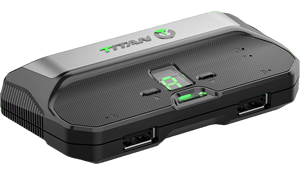
Though these changes offer a certain level of accessibility, neither the announcement nor the accompanying blog post suggests this was deliberate. Rather, the DualSense Edge is a “high-performance, ultra customizable” gamepad ostensibly aimed at competitive gamers. At its heart, the Edge remains the same-old DualSense, and, as such, its accessibility improvements feel incidental rather than intended.
That has been something of a disappointment to gaming accessibility advocates and players who rely on non-standard controls. In the wake of Microsoft’s success with the Xbox Adaptive Controller, Sony’s lack of similarly accessible control options for the PlayStation 5 is starting to stick out like a sore thumb(stick).
Sony’s way or the highway
The DualSense is an unwieldy tool. Compared to its predecessor, the DualShock 4, it spreads inputs across a much wider surface area with a much heavier chassis. “The DualSense is simply too big,” Thomas Russell, a lifelong gamer with spinal muscular atrophy type 2, says. “The biggest issue for me is it’s too wide; it’s also too bulky.”
Many disabled players report that, due to the PS5’s reliance on the DualSense, they are unable to use their consoles as intended. Krissie A.—who wishes to keep her last name anonymous—is a reliability engineer. When she uses the DualSense, she says its size and input-spacing cause her hands significant pain within only 20 minutes. “I’ve been unable to play any PS5 game,” she says, “resorting to watching my husband play the games instead.”

It’s an issue that might be mitigated if PlayStation offered any full accessible control alternatives. But two years after the PS5’s launch, Sony has yet to offer its own accessible control product or to allow generalized third-party accessibility hardware to integrate with the PlayStation 5.
Tools like the Cronus Max and Titan 2, which let consoles pair with other controllers and allowed for button remapping, provided workarounds for a while (though the extra cost was less than ideal for a group of gamers regularly on tight budgets). But in 2021, PlayStation patched out the loopholes that allowed them to work—likely due to the tools’ association with cheating in FPS games.
Input accessibility (and hardware accessibility, in general) doesn’t appear to be a priority for Sony. “I’ve played on Sony consoles since the original PlayStation,” Krissie says. “To be excluded from a console due to my disability is a bit of a kick in the teeth, and, to be honest, quite unacceptable in 2022.”
Gohil tells me that, without third-party tools, “I cannot use my setup to enjoy PS5 games anymore… I don’t feel respected as a gamer. If they don’t want to create a dedicated accessible controller, then at least they should allow third-party devices access.”
reader comments
51